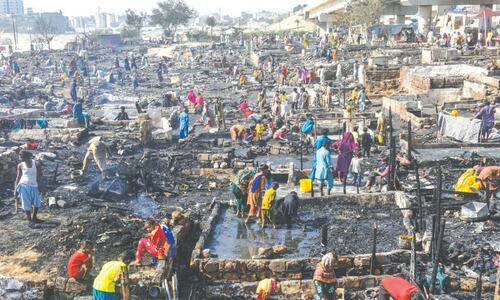LAST week, a vast shanty settlement beside the Lyari river and under Teen Hatti bridge was a plateau of fire. This was one of three large-scale casualties in a blitz of flames across Karachi. Estimates from the Nazimabad fire department say that over 100 shacks went up in smoke. But the state of this community presents a grislier picture. In an expanse of approximately 360 hutments — a figure from the area’s councilor, Chaman — not one is unscathed.
The first few rows of 50 white cotton tents stamped by the Sindh government stitch up an apocalyptic image. Distributed by the city administrator from the ruling Pakistan Peoples Party (PPP) Murtaza Wahab, they stand among charred remains to set the stage for another inferno.
Frightened residents recall waking up to flames on Saturday. Opaque smoke choked the air and their throats, as fire roared through rows upon rows of cloth, plastic and plywood hovels like a contagion. Each dweller is more desperate than the other to show that all they had is now lost. Scorched cloth, broken bangles and medicine bottles, black bricks, oil lamps, petals, memories of goats, hens and savings are dark outlines of the fateful morning and of the firestorm last year.
“We flung infants and children out like dead animals to save them but goats and poultry could not be rescued. It was as dark as night. We couldn’t see the children or the road,” remembers Shankar, a flower seller.
“What should we do with charity such as clothes and bags of ration when wood is so costly and most of us don’t even have a blanket over our heads,” says an angry Ajay, a stage decorator.
Left out to defy the assault of the sun and winter dew, their children are listless. “They have cough and fever. We can’t go to a doctor or give them warm food. Our work has come to a halt. The women here make garlands and gajras, and the men go to fish and flower markets or work as labourers,” says Purkhi, a mother of four.
When asked whether medical aid, food and documentation desks were set up for them, vice president of the PPP’s unit in the area, Amanullah, has a bleak view. “Someone should have died. When everyone survives, there is no help. Last year, there was aid, money and desks. They come here for votes. But most of us have lost our national identity cards to the fire. Assistant Commissioner Sana Tariq and Murtaza Wahab brought 50 tents, 200 blankets and 50 sacks of ration. Now we have to fend for ourselves.”
A portly 80-year-old Pathan on a crutch makes anxious attempts to wade through the crowd and Amanullah pulls him in. “I am the only one who got burnt,” says Rasool Bux. Wrapped in bandages, he tilts his face. Despite his singed cheek, neck, hair, head and arms, Bux is uncounted.
“I am old with a bad leg so the fire got me. These boys carried me out and took me to hospital. Why don’t they give us safe, concrete houses here?”
The UN-Habitat 2003 report, known as the most competent work on the condition of global slums, declares “the extent to which fires pose a threat to the poorest demographic of society is inadequately documented and poorly understood, particularly in Asia, home to the largest number of the world’s slum dwellers.”
However, the situation of informal settlements and their hazards casts an intense shadow of doubt in Karachi. A survey of figures gathered from fire stations in the metropolis last year reveals that 2,000 incidents of fire were reported with 246 in January and 260 in February. Five of the 2,000 instances were recognised as ‘third degree fires’.
Read more: Karachi on fire
Claims of an officer at a central fire station, Inayatullah, support the dismal numbers. “These incidents rise in the dry winter months,” he says.
The slum is represented by the Muttahida Qaumi Movement -Pakistan (MQM-P) in the Sindh Assembly, but the city’s indigenous secular party is faceless in this calamity.
MQM-P lawmaker Mangla Sharma says: “Sindh government wants to create an urban forest along the Lyari river. Therefore, the cause of fire is unknown. This was a public declaration from PPP’s Nasir Shah. Unlike in the past, we do not have the funds to provide relief and want to build pressure in the assembly.”
Clearly, a threat of eviction to the marginalised and most vulnerable section of society is far from a solution. An awareness drive, fireproof tents, sanitation, compensation, access to firefighters and designated escape routes are unlikely to dent PPP or MQM-P coffers, whereas a sprinkler system is a lofty ideal. The two political outfits can also consider a cost-effective inspiration in the regional neighbourhood. In 2019, Dhaka fought fire with an early warning alarm system from South Africa. Lumkani, a detection mechanism, is currently in use in the city’s slums, ensuring swift community action.
In a landscape of incinerated homes and livelihoods, traces such as Shankar’s lone parrot in a cage, Ganga’s diya’s, Rasool Bux’s scars, will serve as markers of salvaged survival and dissent for both parties, especially the MQM-P. Karachi’s populace has learnt to collect absences. For this reason, a poll dole is not its preferred reparation for abandonment.
The writer is journalist and an author
Twitter: Reema Abbasi
Published in Dawn, November 29th, 2021
















































Dear visitor, the comments section is undergoing an overhaul and will return soon.